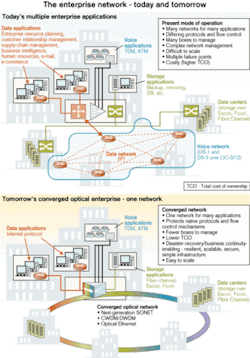Enterprises drive optical innovation
Unfortunately for many IT managers, the decline of the building-local-exchange-carrier (BLEC) and competitive-local-exchange-carrier (CLEC) markets has narrowed their options. But when the local incumbent carrier can't meet their service needs, many enterprises now refuse to accept "no" as the final answer. As a result, today's most influential developers of enterprise and access infrastructure may well be the enterprises themselves.
"The enterprise has a huge impact on the optical access market in general, including what the service providers do," reports David Gross, senior analyst, optical networking research, at Communications Industry Researchers (CIR—Charlottesville, VA). "For example, if you're [a service provider] selling a 100-Mbit service per building, you pretty much have to come in under $200. If the RBOCs can't offer that type of pricing, there isn't necessarily a CLEC who will. But typically, that's the point where an enterprise will say, 'We'd rather just continue to do this internally.'"
And that is precisely what they have done and continue to do, despite the current economic climate. Cincinnati-based Procter & Gamble, for example, constructed a 60-mi, 144-count backbone network to connect its seven major campuses. And Boeing (Chicago) recently awarded an estimated $20-million contract to Nortel Networks (Ottawa, Ontario) to build a 9,000-mi private nationwide network based on DWDM and next-generation SONET technology.
This trend is perhaps even stronger in the nonprofit sector, where many educational institutions, medical facilities, publicly owned utilities, and municipalities are building their own networks to consolidate IT infrastructure and reduce their total cost of ownership (TCO).
The downtown area of Roanoke, VA, for instance, houses the bulk of its municipal operations: the treasurer, commissioner, finance office, sheriff's office and jail, and police department. In remote locations three to five miles away are the library, public works, utilities, and the economic development office. The city wanted to ensure that all of its employees had equal access to the vast amounts of data housed in its Geographical Information System (GIS). The GIS catalogs and updates information about city streets, utility lines, water lines and pipes, parcel layout, and parcel data relative to real estate.
Roanoke's existing ATM network tapped out at OC-12. "As we saw our needs for the future, we needed to centralize all departmental solutions," explains Roanoke technology director Joe Sloan. "With the capabilities provided by SONET, we can now provide the necessary bandwidth, and we don't have to penalize anyone for being a remote location. We have about 30 servers now centrally located in our operations control room. This has allowed us to bring the support infrastructure more in line with keeping everyone and all server platforms within a central area to provide a better level of customer service."
Public safety was a key consideration for Dayton Beach, FL; it has just 68,000 permanent residents, but welcomes more than eight million visitors each year to events like the Daytona 500, Bike Week, Spring Break, and the Black College Reunion. Much of the city's public safety departments were connected via obsolete networks: 17 disparate legacy systems, which made service integration nearly impossible, says Grady Meeks, director of the city's information systems and services. Many of the city's critical public safety offices were connected via an ATM backbone, with 10-Mbit/sec Ethernet connections to the desktop—not nearly enough bandwidth to support streaming video or satellite-based vehicle tracking.
Moreover, replacement equipment was often difficult to find, and the networks were expensive to maintain. Twenty-three of the city's 43 network sites were connected via leased lines, for which the city paid nearly $400,000 a year. Daytona Beach is now putting that money into the construction of a converged network for voice, data, and video. To get elected officials on board, however, proponents of the converged network had to prove a public need, not just an enterprise need.
"We have fiber in major universities in Daytona Beach, and right now we have fiber that runs in front of most of them, and they've asked us to help connect them," reports Meeks. "Also, Daytona Beach is the biggest municipality in the county, and the local counties don't have some of the technical IT staff, so they've asked for interconnectivity as well. The bottom line is if I have fiber to my buildings, I'll save almost $400,000 from paying the local carrier. In the meantime, I'm crossing these other cities. I'm crossing these other schools, and I can help the residents by having a connected community."
The Canadian Advanced Network Research Program (CANARIE) is making inroads with a new service model called condominium fiber networking, which operates similarly to a condominium apartment building. A carrier or fiber broker designs and builds the network, then sells individual strands to institutions and enterprises, which own and control the fiber for a period of 20 years. The typical fiber strand runs about $25,000 for the 20-year duration. Each enterprise is responsible for lighting that fiber, choosing whatever equipment it pleases. Most run Ethernet, says Bill St. Arnaud, senior director of advanced networks at CANARIE, but many deploy SONET as well. Tenants are charged small annual maintenance fees; a third-party contractor, usually the one who initially laid the fiber, is responsible for maintenance and upkeep.Condominium fiber networks are gaining in popularity, particularly in Canada, where virtually all universities and one-third of the country's schools are connected via dark fiber. Montreal, Halifax (Nova Scotia), and Peel County (Toronto) have all built municipal condominium networks, while Alberta has constructed the SuperNet network to link its schools, libraries, hospitals, and government offices. Such networks are attractive, says St. Arnaud, because "you get your money up-front through your anchor tenants. They pay almost 90% of your capital cost, and then as you sell additional fiber, it's almost pure profit." Anchor tenants typically include schools, hospitals, businesses, municipalities, and college and universities.
New York City is considering a similar network implementation, dubbed the New York City Optical Fiber Project. The network will cover the triborough area and consist of 700 fiber strands. Hospitals and universities will purchase about 100 strands on a 20-year indefeasible right of use, and the remaining strands will be sold to commercial entities. The city council is currently weighing testimony on the matter.
The condominium fiber paradigm is also attractive to private enterprises looking to reduce their TCO. For many, particularly those in the financial industry, telecommunications can be their second- or third-largest expense. According to St. Arnaud, Colgate-Palmolive in Cincinnati, Lehman Brothers in New York City, and Ford in Detroit have constructed condominium fiber networks.
As these examples illustrate, some technologies have made it big in the enterprise (Ethernet and SONET), while others are still struggling for widespread acceptance (e.g., passive optical networking and free-space optics). "What's happened [in the enterprise] is there have been a lot of small decisions by a lot of IT managers to buy Ethernet switches and hubs over the last 20 years," observes CIR's Gross.
Thanks to those IT managers, Ethernet is by far the pervasive interface of choice. It is ubiquitous in the LAN, where it accounts for 98% of all traffic. Unlike narrowband DS-1-type services, Ethernet provides very high bandwidth. It can be purchased incrementally in 1-Mbit/sec chunks from 1 Mbit/sec to 10 Gbits/sec. Moreover, traffic can be transported from the LAN to the MAN entirely in Ethernet, eliminating the need for protocol conversions and minimizing the delay that might result from these conversions.
"In order to get costs down, you need a fairly wide market to embrace the technology. The more volume there is, the cheaper the box will get," says Gross. "Somebody somewhere has to generate that volume, and it's those IT managers—many of them making similar decisions—that ultimately make that happen. It hasn't happened and I don't think it's going to happen any time soon with PON [passive optical networking]; the same with FSO [free-space optics]."
One technology that has been making inroads in the enterprise space is CWDM. A key advantage of WDM is its protocol and bit-rate insensitivity. "You can take any enterprise application, any enterprise protocol, any enterprise bit rate, and you can transfer that over a CWDM infrastructure," notes Nortel's Lounsbury. Many service providers are now using CWDM to connect the enterprise edge into their core networks. Of course, not every enterprise can deploy CWDM technology; they must first have access to fiber.
When an enterprise does not have readily accessible fiber, the other alternative is SONET, which is available to an estimated 85% of U.S.-based enterprises, says Lounsbury. Next-generation SONET, coupled with generic framing procedure, can support voice, video, and data applications—all while delivering guaranteed quality of service.
But what if an enterprise doesn't want to build its own network or enter into a 20-year leasing agreement for fiber in a condominium network? Enter a CLEC like AboveNet, formerly Metromedia Fiber Network (White Plains, NY), which has recently adopted new terminology for its products and services to better reflect today's enterprise needs.
"We used to talk about fiber and bandwidth," says Tom Byrnes, senior vice president of sales and marketing at AboveNet. "What we're trying to do now is focus on products that meet application requirements." The carrier provides what it now calls gateway products (fiber), network products (IP transit and bandwidth), and server products (hosting, storage, and application management services).
AboveNet recently won a contract from the New York Mercantile Exchange (NYMEX), the largest physical commodities exchange in the world. The CLEC is connecting the exchange's Manhattan-based trading floor with its backup facility in Long Island to allow for real time data mirroring via a private unshared DWDM network. That and other bandwidth-intensive applications would not be possible without the migration of advanced optical technology to the enterprise, says Byrnes.
"Thanks to the optical products that we and others are rolling out, [enterprises] have the ability to take high-bandwidth applications and make them viable," he asserts, adding that AboveNet is also targeting enterprise customers who have not had sufficient justification for bandwidth in the past. "We want to give them the opportunity to get bandwidth at a price point that makes it attractive for them to enable new applications. And of course, for us, the anticipation is that they will grow from where they are into a usage like NYMEX."
Cable multisystem operators (MSOs) also have an increasingly larger presence in the enterprise space. While not blanketing the market the way the traditional CLECs did, cable MSOs are more relevant than their sales figures would suggest, reasons CIR's Gross. "The cable companies have become an important competitor to the RBOCs, not so much in terms of sales but in terms of the impact they have on pricing," says Gross. "They are going in and being very aggressive on pricing in order to win customers."
The increasingly independent spirit of enterprises, the tenacity with which some CLECs have hung on, and the encroachment of the MSOs should lead to a response from the RBOCs. "A lot of these large enterprise networks are doing it on their own—with fiber they bought for themselves. They manage it on their own, and they buy their own equipment. From the RBOC standpoint, that's money that they aren't collecting," says Gross. "That's really where the RBOCs are being forced to innovate. They have to use the technologies that these large corporate accounts are using; otherwise, they are not going to get that traffic on their network and collect that revenue."


